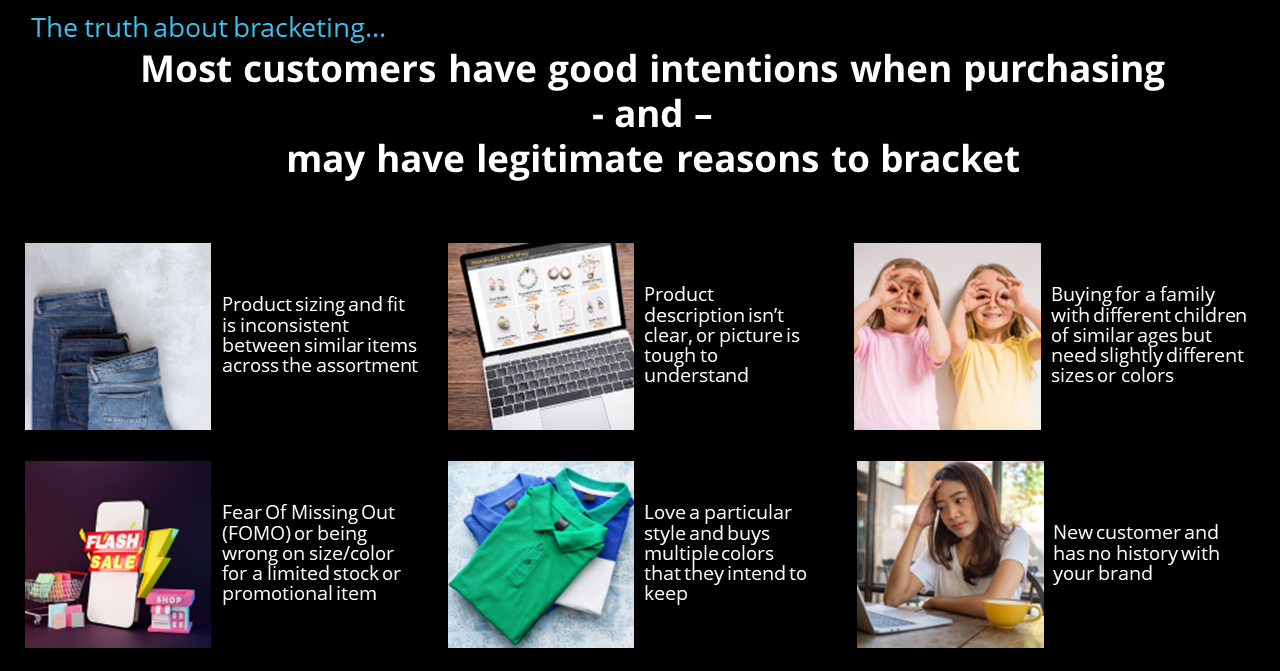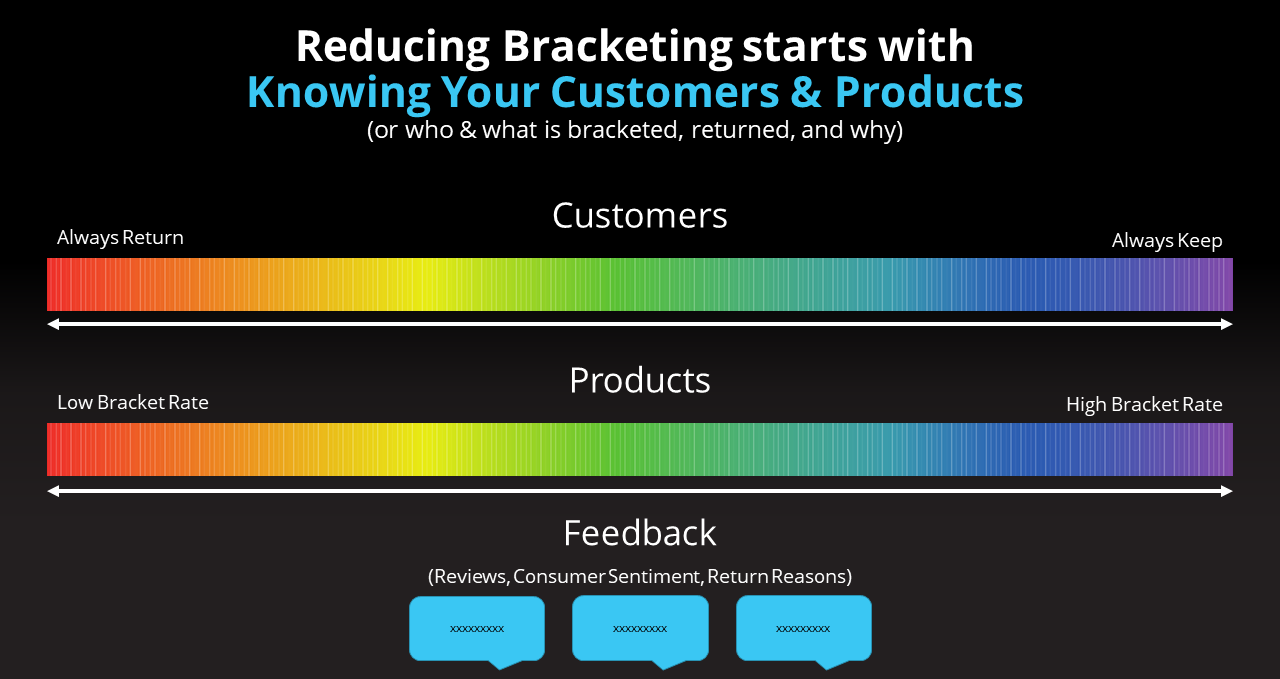You don't have to use a sledgehammer approach to reduce bracketing. With an intimate understanding of your customers and products you can create positive experiences that improves revenue, profitability and customer loyalty.
Coresight Research recently reported that 24.4% of all online apparel purchases will be returned. Not surprisingly, size/fit was the #1 reason for returns. Consequently, bracketing, or the process of shoppers buying multiple sizes and colors of the same style, has become the latest target for why retailers struggle with returns. The argument is not without merit, as 63% of shoppers bracketed their online purchases in 2022, up from 58% just a year earlier.
Bracketing runs afoul with profitability, especially in ecommerce and DTC businesses for brands and retailers. According to Mike Relich, Executive Vice Chair of PACSUN, "shipping parcel costs are up 40-50% YOY, and retailers are expected to cover that." Returning an item, on average, costs 2/3 the price of the item. In other words, that $50 pair of pants costs a retailer $33 when a consumer returns it. So if a shopper bought 3 and returned 2, the retailer is losing money.
Beyond profitability, returns inhibit retailers' inventory and working capital. Any item undergoing a return locks up the working capital of that item while it is going through processing. Additionally, a buy anywhere, return anywhere retail offering, while great for customer experience, means that inventory can suddenly show up at a location from which it is never sold.
And there is still one more problem, environmental footprint. All these returns cause significant issues with CO2 emissions, packaging, and those that end up in landfill. Fashion retailers are already pressured to improve their sustainability practices, but every return inhibits that effort.
So yes, the returns from bracketing are an issue.
With all these problems, many articles point to free returns, shopping behavior, and liberal return policies as the problem. But in discussions with retailers, they know the problem is more complex than these simple reasons.
Savvy retailers thrive on understanding their customers and strive to deliver incredible experiences regardless of their customers' shopping behaviors.
Generally, most shoppers have good intentions when purchasing and may have legitimate reasons to bracket. Some of those reasons are good for retailers.
- The product sizing and fit are inconsistent between similar items across the assortment, so the shopper is never sure exactly what size they are.
- The product description isn't clear, or the picture gives the wrong impression of the item.
- The shopper is scared about missing out on limited or promotional items, so they buy more to ensure they get the right size/color rather than guessing what they think is the right size, only to have to return it and their size is no longer available.
- The shopper loves a particular style and buys multiple colors they intend to keep.
- The shopper buys for a family with children of similar ages and needs slightly different colors or sizes.
- The shopper is a new customer and has no history with your brand.
- Or one's body shape changed, and they are unsure what size they are.

There are always those customers that abuse policies or participate in fraud. Retailers must always watch out for that, but they shouldn't punish everyone for a few bad apples. According to a University Study, most shoppers will have strong negative emotions toward retailers who enact these policies. Conversely, they react positively towards policies that target serial returners. And sometimes, those Bracketers or "bad apples" might not know that their actions are harmful or different from everyone else.
Reducing bracketing costs starts with knowing your customers and products. Retailers must understand who and what products are bracketed, returned, and why. The goal is to have customers keep their merchandise, not through guilt or complex processes, but by changing customer behavior through positive influences and eliminating customer confusion during shopping.

So how can you change behavior without punishing or discouraging that customer? Imagine that you can score every customer based on their shopping behavior; you can start to identify which customers have a propensity to return items. With that knowledge, there are several actions that you can take which can be perceived as positive:
- Provide sizing recommendations based on their recent history.
- Change promotional offers. BOGOs might not be the best option.
- Educate and entice the shopper.
- "You return more than your peers. Your "KeepScore" is 82, but if you raise it to 90 by these actions, we will give you this benefit, coupon, or badge."
- Empower the shopper to make a difference.
- "We know returns are necessary sometimes. Yet, returns have "x" impact on the environment. We want to reduce returns by "y" amount, which will have "z" impact. Can you help us achieve our goal by these actions?"
- Encourage an exclusive in-store fitting event for them and their friends. Luxury retailers could create distinguishing experiences and brand loyalty while increasing their customer base.
Employed correctly, tactics like these can nudge customers' behavior and result in fewer returns from bracket buying.
Yet as mentioned prior, the blame for bracketing does not lie only on shoppers. Brands, retailers, and suppliers have accountability too. Below are steps that can be taken.
- Identify the root cause of the return by listening to the customer through avenues other than reason codes. These include customer reviews, social media, and even call logs.
- Did a customer buy several T-shirts that they intended to keep, only have one shrink during washing? Therefore, they returned the entire order.
- Did the colors, description, or website copy not accurately align with customer perceptions? We've seen cases where removing or adding one word or changing how a model sits or stands completely shifted the trajectory of returns.
- Don't market items with a high bracket and return rate in prominent positions on the website. They may be great sellers, but if people aren't keeping them, don't encourage their sales. Instead, look for items with a low return rate that go well with a collection.
- Address any size inconsistencies within your brand or suppliers and work towards standardizing it or providing an additional measure. Our recent study showed that petite size return rates ran 10-30 percentage points higher than standard sizes. These numbers indicate that the product or the marketing of that product selling aren't designed well for the audience.
- Identify the vendors by category that have higher returns. These insights give you another level of visibility to ensure they perform to your and your customers' standards.
Bracketing and returing are wreaking havoc on brands' and retailers' bottom lines. But by understanding customer behavior, product performance, and bracketing measurements, retailers can enact positive actions that reduce the bracketing rates while driving more loyal customers and a profitable business.